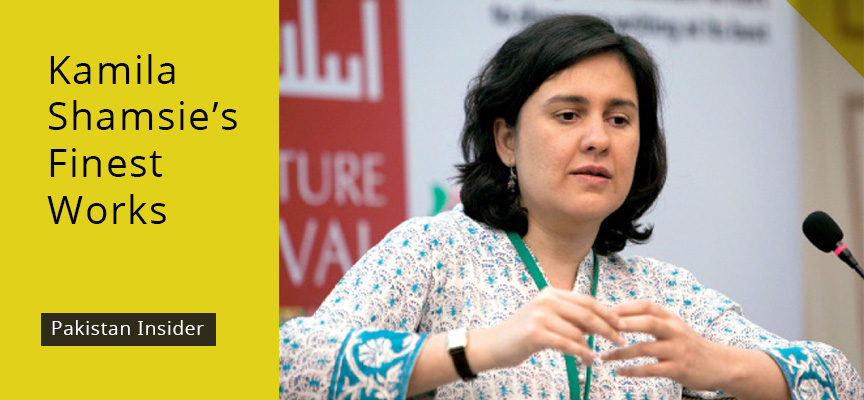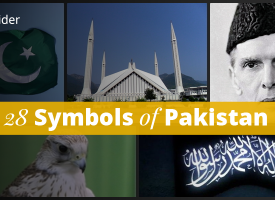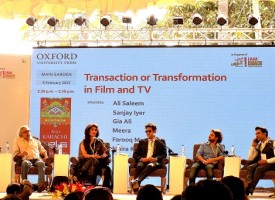Kamila Naheed Shamsie is an acclaimed Pakistani novelist who weaves tales of great emotional complexity set against a historical backdrop, across continents and eras. Below are some of her finest works:
Salt and Saffron
“How horrifying that morning when you wake up and your first thought is not of the person who has left. That’s when you know, I will never die of a broken heart.”
Salt and saffron is a far cry from the cookbook it appears to be titled as, but it does have all the right seasoning and content, making it the perfect recipe for a bestseller. The tale is woven across continents, time periods and three generations of the family of the Dard-e-dils, based in the subcontinent with a glorious past they refuse to let go of. The plot is focused on the life and love of one of these Dard-e-dils, Aliya, but through her, it reaches back to more lives and loves. One London-bound flight forces Aliya to question all she knows about herself, her family’s history, and the class values of herself and those closest to her. The book raises some excellent questions about the effects of the partition, the superstitions that govern our actions, and love that refuses to conform to society’s standards; and by the end of the read, it has managed to answer some, if not all of them.
Burnt Shadows
“Stay. Stay. Stay. She should have repeated it like a madwoman, banged her head against the wall in a frenzy, hit him and wept. She should have said it just one more time, just a little more forcefully. She should have taken his dear, sweet head in her hands and kissed his eyes and forehead. Stay.”
The book tackles many grave issues and questions many narratives, among which reign supreme those concerning the War on Terror, world powers, and the atomic bomb, woven through with the ideals of friendship and love. It is based on believable characters and deals with the themes of racism, betrayal and war beautifully. The novel is set in three parts; the first in 1940s when Hiroko Tanaka is living in Nagasaki and engaged, losing her love and almost her life to the atomic bomb, and thereafter going to India to visit her fiancé’s sister; finding love in the process. The second part focuses on Pakistan in the 1980s, and the third part takes place after 9/11 centered on another generation.
Kartography
“Somewhere deep within the marrow of our marrow, we were the same.”
The title refers to the study of maps, which take on a deeply symbolic meaning as the tale progresses. Maps are the escape of choice for Karim, childhood best friend of the protagonist, Raheen. While Karim wants to map down each street he knows of, Raheen wants to feel the actual heartbeat of every location. “You want to hear the heartbeat of a place?” asks Karim. “Do you know how hard your heart beats when you’re lost?”
Karim and Raheen’s parents were once engaged to one another; they had traded partners in a “Fiancee swap”, leaving Raheen to try and uncover the truth behind it years later. The descriptions of Karachi make this book a piece of art, forever burrowing for itself a space in the heart of any Karachiite. The novel deals with themes of history, ethnicity and love, as well as that of destiny. What is the truth behind soul mates and how fluid is fate really?
A God in Every Stone
“The shaking had stopped, outwardly, but her mind couldn’t hold a thought for any length of time without splintering apart. She took a deep breath, thought of a cliff above the sea, the taste of figs on her tongue, a man’s finger touching the jut of her wrist, the sea so blue she thought it might drive her mad though she understood nothing of madness then.”
This excellent work boasts an unlikely pair of characters: Vivian Rose Spencer, a brave English archaeologist, and Qayyum Gul, a young Pathan who fought in the world war for the British forces. The novel is set largely in British India between 1914 and 1930. The two meet on a train bound for Peshawar, her looking for her lost love and an artifact, him simply on his way back home. In their brief encounter with each other, they remain unaware that their lives are to be intertwined, only to meet again 15 years later. As Vivian searches for her love and Qayyum for his individual morality, we learn of betrayal, history and independence. Vivian becomes a mentor to a young boy, Najeeb, and Qayyum goes from a soldier to a rebel, as actual events from history serve as the backdrop.
Shamsie brings to live the city of Peshawar, and describes its sights and sounds in a way few others have. For her, the city has “more past than present there” with two and a half thousand years of history just waiting to be uncovered.
Broken Verses
“In his prison poems, the bars on his windows are merely the grid through which he sees shooting stars, each lash of a whip is a reminder of the insecurity of tyrants, and a rumour that orders for his execution have been dispatched is reason to weep for the executioner.”
How do you become something more than an abandoned daughter, one the mother didn’t care to stay for, neither to return to? How do you change your narrative and take charge of your life once more? These are the questions this book raises, and seeks to answer to a certain extent. Aasmaani Inquilab’s mother Samina Akram was a famous Pakistani political activist who disappeared without a trace fourteen years ago. Aamaani is used to her mother following her lover poet whenever he was forced into exile for his political writings and views, always leaving her daughter on her own. The poet was beaten to death by the government two years later. So where is her mother? A letter addressed and delivered to Aasmaani, the first of many more to come, written in a private code, is the first clue to the mystery.








No comments!
There are no comments yet, but you can be first to comment this article.